ikfoundation.org
The IK Foundation
Promoting Natural & Cultural History
Since 1988


 Crowdfunding Campaign
Crowdfunding Campaignkeep knowledge open, connected, and growing on this textile history resource...
SHOP WINDOWS
– the Drapery Trade in the long 19th century
Display windows became popular in the last decades of the 18th century in London, giving rise to clear improvements for showing off such goods as drapery in the most desirable way – a novelty which was also introduced in many other English cities and towns around the year 1800. This innovation was primarily due to the technical advancement of producing larger glass windows, but secondarily, this also had an important role in the growth of a consumer society. Previous expositions towards the shop front had been through much smaller cased windows, with a limited view for prospective customers to admire luxury goods or decide to purchase necessary everyday clothes for their family. A few illustrative examples will form this brief study, giving some evidence for the change in how drapery and ready-made garments were presented in the shop windows for a period of more than one hundred years.
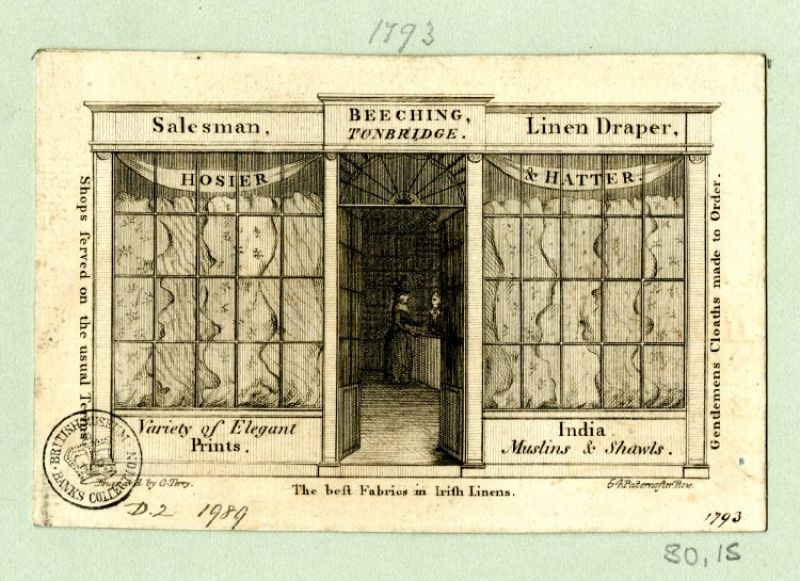 An informative depiction of an early shop window by a Linen draper, Hosier & Hatter in Tonbridge 1793. The shopkeeper took the liberty of displaying muslins, linens and perhaps also silks hanging in folds in the large windows. Notice the lady customer and shop assistant positioned by the counter in the poor lighted shop. Courtesy of: © Trustees of the British Museum, Trade cards, Banks 80.15. (Collection online).
An informative depiction of an early shop window by a Linen draper, Hosier & Hatter in Tonbridge 1793. The shopkeeper took the liberty of displaying muslins, linens and perhaps also silks hanging in folds in the large windows. Notice the lady customer and shop assistant positioned by the counter in the poor lighted shop. Courtesy of: © Trustees of the British Museum, Trade cards, Banks 80.15. (Collection online).This case study of the drapery trade will give a glimpse into how the larger display windows increased the shopkeepers' possibilities to present imported luxury goods, the draping of fabrics and, further on in time, ready-made garments of the latest fashion dressed on wax dolls or adjustable stands. However, the smaller windows were in use parallel with the novel display windows, particularly in many old properties built before the invention and the desire for large-scale models. Even if the new design from the late 1700s and the first half of the next century stretched almost from floor to ceiling, each window was made up of twenty or more separated glass panes – like in the image above.
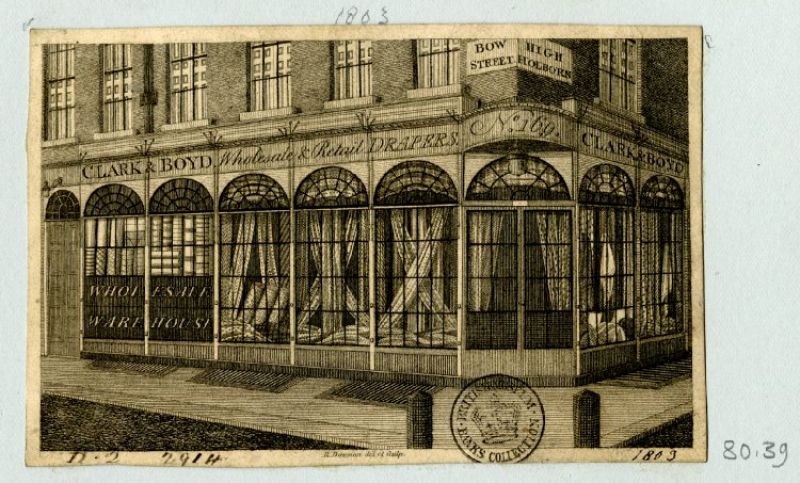 The outline for this type of corner warehouse of Clark & Boyd linen drapers in Holborn/London dated 1803 in pencil, opened up further possibilities with its larger number of display windows – drapery goods showed off in folds, gathered in various decorative ways and neatly rolled. Courtesy of: © Trustees of the British Museum, Trade cards, Banks 80.39. (Collection online).
The outline for this type of corner warehouse of Clark & Boyd linen drapers in Holborn/London dated 1803 in pencil, opened up further possibilities with its larger number of display windows – drapery goods showed off in folds, gathered in various decorative ways and neatly rolled. Courtesy of: © Trustees of the British Museum, Trade cards, Banks 80.39. (Collection online).It must also be emphasised that the opening hours after dark in many ways limited the view of goods for sale, despite the large-size display windows. Daylight was overall of greatest importance for traders and customers alike, which, among many matters, is thoroughly described in the book Shops and Shopping 1800-1914 by Alison Adburgham. This meant that oil lamps were replaced by gas lighting in the early to mid-19th century, and at the end of the described period, electric lighting was gradually introduced. Unsurprisingly, rural environments often had a somewhat late introduction of innovations such as display windows and effective lighting compared to urban environments and even to a greater degree in comparison to London.
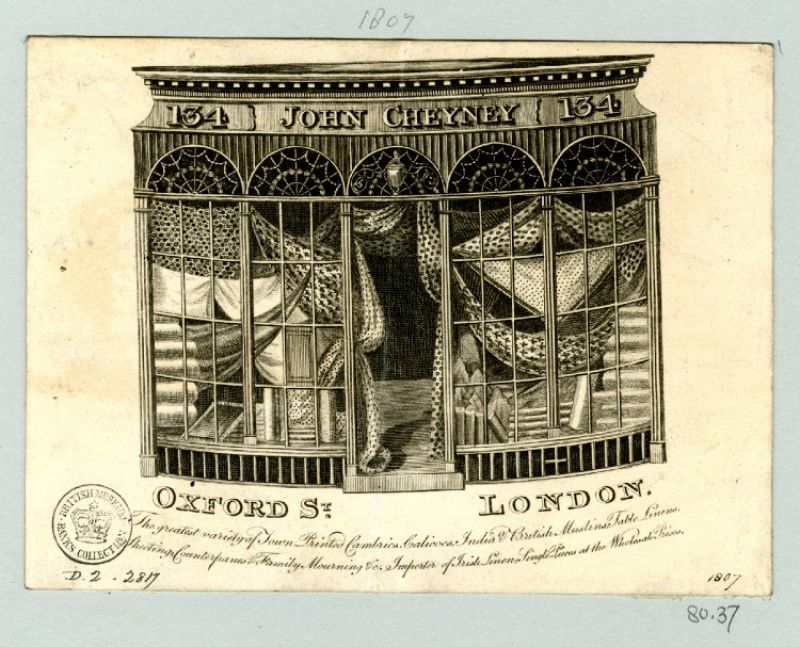 A third example of trade-cards showing display windows is illustrated from a small drapery shop in 1807 – who sold a large selection of printed muslins, linens etc at Oxford Street in London. Courtesy of: © Trustees of the British Museum, Trade cards, Banks 80.37. (Collection online).
A third example of trade-cards showing display windows is illustrated from a small drapery shop in 1807 – who sold a large selection of printed muslins, linens etc at Oxford Street in London. Courtesy of: © Trustees of the British Museum, Trade cards, Banks 80.37. (Collection online).A very informative observation was made by the young Swede J P Bager, who travelled via Denmark and Germany to his destination in England in 1840. Already during his second day in London (29th August), he noticed the busy central streets in his journal;
‘A Considerable obstacle for making headway on the streets is, more than the swarming crowds of people, through which one quickly learns to negotiate on the excellent wide pavements, the seductively inviting and constantly beautiful and tastefully varied boutiques… In these windows one can see either a lady or a proud man, made of wax, dressed in the most fashionable clothes, hats, millinery and other adornments so several people can inspect from all sides as they slowly wander around. The owners of houses with such exhibitions are mostly perfumery or fashion traders… But how would it be possible to count all these unusual curiosities that are displayed in the countless London boutiques that in multifarious ways attract the attention and interests of strangers and tempt them to buy, and with constantly changing ingenuity for speculation and capricious fashion, they bring fourth new items.’
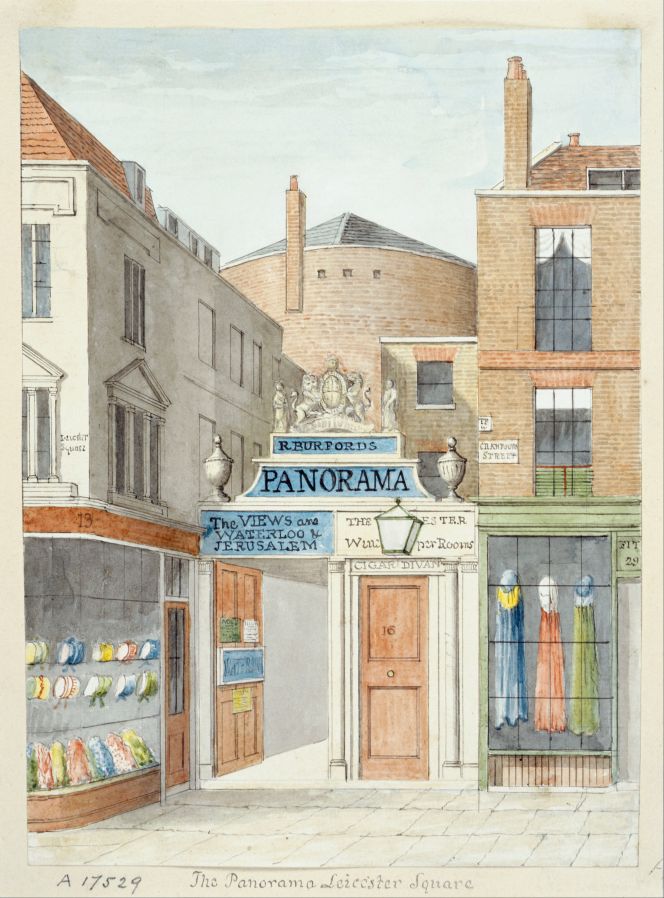 This drawing/watercolour by unknown artist of “The Panorama, Leicester Square” in London gives a rare view in colour of window dressing in circa 1840s, with cloaks and matching hats etc arranged in a colourful display. Courtesy of: Museum of London. (A17529, Google Art Project, Electronic Source).
This drawing/watercolour by unknown artist of “The Panorama, Leicester Square” in London gives a rare view in colour of window dressing in circa 1840s, with cloaks and matching hats etc arranged in a colourful display. Courtesy of: Museum of London. (A17529, Google Art Project, Electronic Source).Shop windows also became an essential part of everyday town and city life, making it possible for more and more inhabitants – when the standard of living rose for many during the 19th century – to buy goods displayed in such windows. Shops and shopping became more visible and even if you could not afford to purchase the desirable luxury items or fashionable clothing on display, the existence and the rapid changes of such merchandise became more widespread than ever before to larger groups of the society.
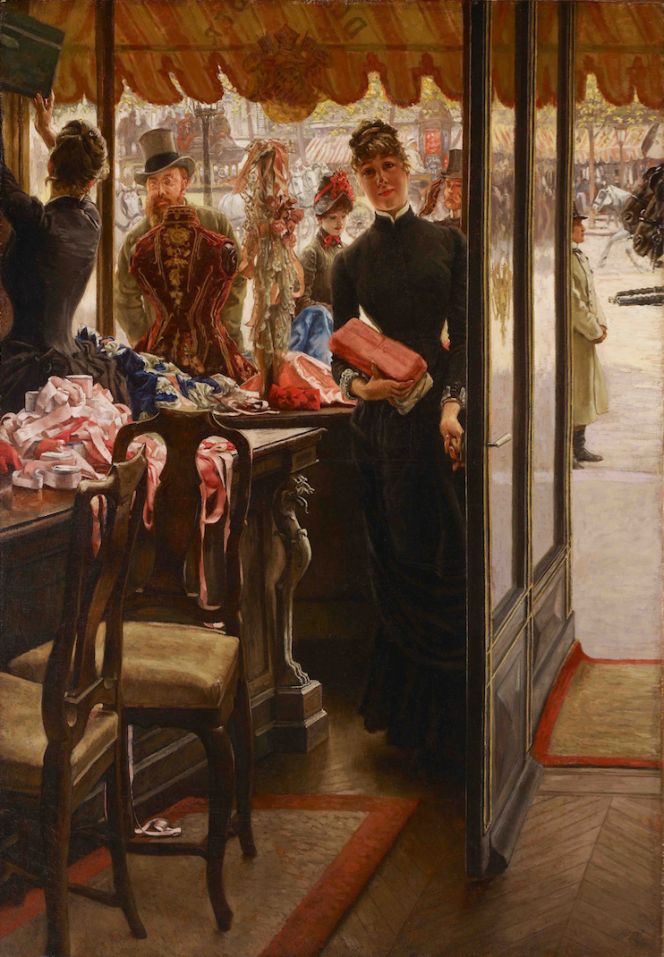 The oil on canvas depicting a shop girl or “La demoiselle de magasin” in Paris, dating 1883-1885 by James Tissot furthermore presents an unusual view of a shop window. By looking out on a marketplace through the window – it is not only possible to study the interior and the daily work of the shop assistants, but also the window arrangements and in particular the exquisite jacket-bodice (lacking sleeves) placed on the adjustable stand. Courtesy of: Art Gallery of Ontario. (67/55, Electronic Source).
The oil on canvas depicting a shop girl or “La demoiselle de magasin” in Paris, dating 1883-1885 by James Tissot furthermore presents an unusual view of a shop window. By looking out on a marketplace through the window – it is not only possible to study the interior and the daily work of the shop assistants, but also the window arrangements and in particular the exquisite jacket-bodice (lacking sleeves) placed on the adjustable stand. Courtesy of: Art Gallery of Ontario. (67/55, Electronic Source).A Guide to Window-Dressing for the drapery trade, printed in 1883, was additionally the first book describing how to arrange a window display professionally. This fact gives evidence that before this year, personal taste and experience, inspiration from other traders, traditions, etc, must have been the main influence available for shopkeepers, together with their assistants and apprentices alike, to attract as many customers as possible to their decorative shop windows.
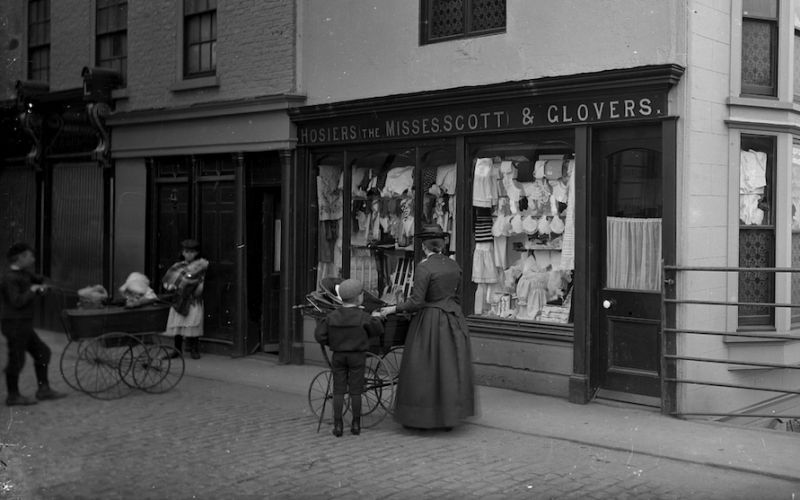 For the 1890 to 1914 period it is easier to find examples of larger and larger display windows in the ever extending department stores in many towns and cities, these snapshots are immortalised in contemporary photographs often with passers-by or via art works or printed advertisements in magazines/newspapers/catalogues. However, even if luxury goods may be associated with window displays most shops in smaller towns arranged ordinary clothing in their windows, like for example The Misses Scott’s establishment in Whitby circa 1895 – a trader described in detail in one of the earlier essays. (Courtesy of: Frank M. Sutcliffe, Whitby Museum, Photographic Collection, part of photograph.)
For the 1890 to 1914 period it is easier to find examples of larger and larger display windows in the ever extending department stores in many towns and cities, these snapshots are immortalised in contemporary photographs often with passers-by or via art works or printed advertisements in magazines/newspapers/catalogues. However, even if luxury goods may be associated with window displays most shops in smaller towns arranged ordinary clothing in their windows, like for example The Misses Scott’s establishment in Whitby circa 1895 – a trader described in detail in one of the earlier essays. (Courtesy of: Frank M. Sutcliffe, Whitby Museum, Photographic Collection, part of photograph.)Sources:
- Adburgham, Alison, Shops and Shopping 1800-1914, London 1964.
- Bager, J P, Impressions of London from the Late Summer of 1840, London & Whitby 2001.
- British Museum, Collection Online (Search words ‘trade cards textile’).
- Hansen, Viveka, The Textile History of Whitby 1700-1914 – A lively coastal town between the North Sea and North York Moors, London & Whitby 2015.
- Hansen, Viveka, ‘Textile Shopkeepers – in a Coastal Town’, iTEXTILIS Essays, No: XLV | December 17, 2015.
- Wikipedia (Search words: ‘A Guide to Window Dressing’ [book printed in 1883]).
Essays
The iTEXTILIS is a division of The IK Workshop Society – a global and unique forum for all those interested in Natural & Cultural History.
Open Access Essays by Textile Historian Viveka Hansen
Textile historian Viveka Hansen offers a collection of open-access essays, published under Creative Commons licenses and freely available to all. These essays weave together her latest research, previously published monographs, and earlier projects dating back to the late 1980s. Some essays include rare archival material — originally published in other languages — now translated into English for the first time. These texts reveal little-known aspects of textile history, previously accessible mainly to audiences in Northern Europe. Hansen’s work spans a rich range of topics: the global textile trade, material culture, cloth manufacturing, fashion history, natural dyeing techniques, and the fascinating world of early travelling naturalists — notably the “Linnaean network” — all examined through a global historical lens.
Help secure the future of open access at iTEXTILIS essays! Your donation will keep knowledge open, connected, and growing on this textile history resource.
been copied to your clipboard




– a truly European organisation since 1988
Legal issues | Forget me | and much more...
You are welcome to use the information and knowledge from
The IK Workshop Society, as long as you follow a few simple rules.
LEARN MORE & I AGREE







